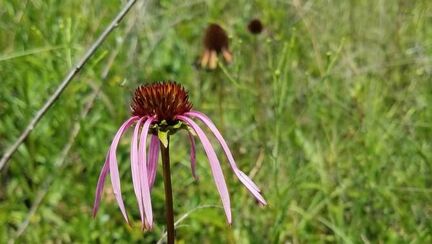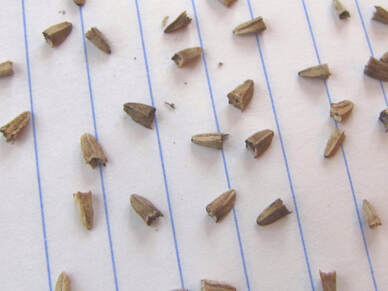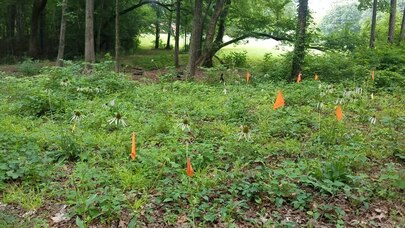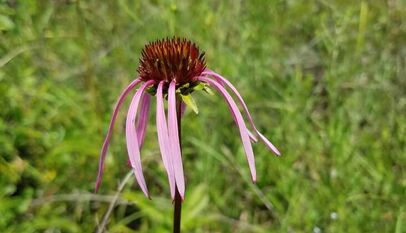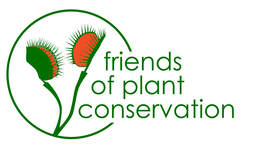Species Enhancement
Species enhancement is the intentional manipulation of a species' population via augmentation, reintroduction, introduction, or assisted migration for the purpose of increasing population size, genetic diversity, or representation.
The following are defined by the NC Scientific Community regarding species enhancement on PCP preserves.
AugmentationAdding individuals to improve growth of an existing population by increasing population size or diversity.
|
ReintroductionRelease of individuals into a formally occupied site after native population became extinct.
|
IntroductionDispersal, by humans, of a species outside of its historically known native range.
|
Assisted MigrationIntentional introduction of organism outside of its native range to counteract the negative effects of climate change.
|
Species enhancements of imperiled plants are done with great care and consideration for genetic, ecological, and other factors. These practices are used on a case by case basis when other management methods have been exhausted. The NC Scientific Committee compiled a set of criteria to be followed by the PCP when making these decisions.
Example: Augmentation of the Smooth Coneflower in Durham County
BackgroundThe Smooth Coneflower (Echinacea laevigata), a federally endangered species, is protected in North Carolina under the NCPCP. At the Durham PCP preserves, forest thinning and prescribed burns maintain prime habitat for this rare plant. Augmentation using on site material was deemed necessary when less than 10 individuals were recorded. Smooth Coneflower augmentation work was done in accordance with the above criteria, with proper documentation, management, and approval from all parties.
|
Sustainable collection of Echinacea laevigata seedsSeeds were sourced in-situ (on site) from the population being enhanced, this avoids unintentional genetic mixing between populations.
The seeds of Smooth Coneflowers are technically fruits, called achenes. They mature during the fall and must go through cold stratification in order to germinate. Stratification is a natural process in which seed coats break down during the changing seasons of warm, dry summers and cool, moist fall and winters.
"CPC recommends collecting no more than 10% of an individual or population seed production in one season and no more than 10 out of 90 years." -CPC Rare Plant Academy Growing Echinacea laevigataPreserve stewards, Herb and Pat Amyx, documented the growing process of Smooth Coneflower off-site.
Success and Long Term MonitoringReproduction from augmented individuals at the Durham Diabase Sill preserve has been documented, marking this project as a success in enhancing the viability of Smooth Coneflower populations at this site.
The population will continued to be monitored by PCP and FoPC staff and volunteers, for long term evaluation reintroduced plants and changes in overall population.
|
Site selection for augmented individualsIt is crucial to ensure that the site is suitable to the habitat needs of the species and is protected from harmful disturbance.
|
Smooth Coneflower Augmentation At a Glance
|
|
Photos provided by PCP Staff and FoPC Intern.
Sources and Additional References
Species enhancement
Rare Plant Reintroductions and Conservation Translocations, CPC Rare Plant Academy.
Guidelines for the translocation of threatened plants in Australia. 2018. Commander, L.E., Coates, D., Broadhurst, L., Offord, C.A., Makinson, R.O. and Matthes, M. Third Edition. Australian Network for Plant Conservation, Canberra.
Guidelines for Reintroduction and Other Conservation Translocations. Version 1.0. IUCN/SSC (2013). Gland, Switzerland: IUCN Species Survival Commission, viiii + 57 pp.
Reintroducing Native Plants Into the Wild. Parkin, Mary. U.S. Fish and Wildlife Service, written for the New England Plant Conservation Program (NEPCoP)
Reintroduction of rare and endangered plants: common factors, questions and approaches. 2007. Guerrant, O. Edward; Kay, N. Thomas. Australian Journal of Botany, 55, 362-370.
Reintroduction of the endangered and endemic plant species Cochlearia bavarica - Implications from conservation genetics. Kaulfuß, Franziska and Reisch, Christoph. 2017. Ecology and Evolution. 7:11100-11112. https://onlinelibrary.wiley.com/doi/pdf/10.1002/ece3.3596.
CPC Best Plant Conservation Practices to Support Species Survival in the Wild. Center for Plant Conservation. Web Version.
Evaluating Translocation Successes and Challenges:A video presentation on translocation case studies performed in Florida.
Guidelines for the translocation of threatened plants in Australia. 2018. Commander, L.E., Coates, D., Broadhurst, L., Offord, C.A., Makinson, R.O. and Matthes, M. Third Edition. Australian Network for Plant Conservation, Canberra.
Guidelines for Reintroduction and Other Conservation Translocations. Version 1.0. IUCN/SSC (2013). Gland, Switzerland: IUCN Species Survival Commission, viiii + 57 pp.
Reintroducing Native Plants Into the Wild. Parkin, Mary. U.S. Fish and Wildlife Service, written for the New England Plant Conservation Program (NEPCoP)
Reintroduction of rare and endangered plants: common factors, questions and approaches. 2007. Guerrant, O. Edward; Kay, N. Thomas. Australian Journal of Botany, 55, 362-370.
Reintroduction of the endangered and endemic plant species Cochlearia bavarica - Implications from conservation genetics. Kaulfuß, Franziska and Reisch, Christoph. 2017. Ecology and Evolution. 7:11100-11112. https://onlinelibrary.wiley.com/doi/pdf/10.1002/ece3.3596.
- A published research paper explaining reasons genetic conservation should be included in rare plant translocation and reintroduction projects. The study was conducted in Germany, regarding a rare species called Cochlearia bavarica. Genetic differences were found between populations of different geographic location, suggesting that reintroduction efforts avoid mixing genetic material between these populations.
CPC Best Plant Conservation Practices to Support Species Survival in the Wild. Center for Plant Conservation. Web Version.
- A thorough instructional document on seed banking, seed banking alternatives, genetic guidelines for a conservation collection, plant reintroduction and translocations, documentation and data sharing. This is a great document for more detailed steps on conducting rare plant conservation work, with great resources listed.
Evaluating Translocation Successes and Challenges:A video presentation on translocation case studies performed in Florida.
Seed Saving Resources
Stratification: A webpage further explaining the process of stratification and ways it is used in preparing seeds to plant
NC Botanical Garden: The NC Botanical Garden, renowned for their seed banking efforts and plant conservation, is a valued partner of the PCP.
Collecting Seeds from Rare Wild Plants: CPC Rare Plant Academy guidelines on collecting seeds from rare wild plants
NC Botanical Garden: The NC Botanical Garden, renowned for their seed banking efforts and plant conservation, is a valued partner of the PCP.
Collecting Seeds from Rare Wild Plants: CPC Rare Plant Academy guidelines on collecting seeds from rare wild plants
Smooth Coneflower Resources
The Developmental Stages of the Smooth Coneflower - Echinacea laevigata:
A blog post written by Preserve Steward, Herb Amyx, regarding the Smooth Coneflower stages of development captured during the Durham Diabase Sill augmentation process.
A blog post written by Preserve Steward, Herb Amyx, regarding the Smooth Coneflower stages of development captured during the Durham Diabase Sill augmentation process.

